S-TEC and GPS Installation
![]()
S-TEC and GPS Installation |
|
by Jim Petty
|
This article appeared in the December 2000 Falco Builders Letter |
Four years ago I promised an article on my installation of a Navaid Devices autopilot in my Falco. I'm a little late (I really do hate to write), so instead I'm now writing about installing an S-TEC System 50 autopilot, a Garmin GPS 400 and a MagnaFlite lightweight starter in my Falco. I've removed the Navaid autopilot, and it's on its way to Mike Wiebe. It did a good job as a wing leveler, except in heavy turbulence, and a decent job tracking VORs, though I didn't use it in that mode very often.
First, I'd like to say that Cecil Rives' article on installing an S-TEC System 30 in his bird was very timely and a big help to me.
The System 50 differs from the System 30 primarily in having the computer as a separate panel-mounted unit which contains both the roll and pitch control computers. Both systems are otherwise functionally the same and cost the same, as far as I can tell. When I ordered the System 50, S-TEC didn't have a Falco installation kit (and probably still doesn't), so I ordered an SF-260 kit instead after talking with the S-TEC folks. It worked out fine, all the cable lengths were good except the cable to the altitude hold pressure transducer could have been a few inches shorter. Oh, one other thing -- the SF-260 apparently has heavier control cables, so be sure to specify bridle cable clamps for 1/8" cables.
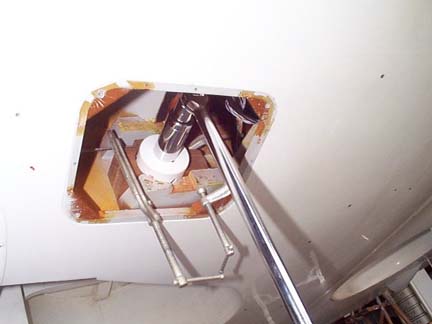
Cutting the capstan hole.
With the panel sitting on my breakfast table, I modified the panel hole below the CDI to take the System 50 computer (it takes an octagonal hole), installed the computer, replaced the old turn and bank with the turn coordinator, replaced the DG with an S-TEC DG with autopilot heading bug, installed the pressure sensor on the side of my glove box, and wired and plumbed everything together.
I installed a 28-pin connector at the empty J4 hole on the back of the panel and brought all the autopilot wires (there are 17 of them) that leave the panel through it.
I don't know if my bird has a slightly different frame 3 location
than Cecil's, or if it's the difference between the Systems 30
and 50, but I didn't have to move my panel back for the connector
on the computer to clear the front fuel tank. However, I did
have to modify the cable connector so the cable came off at a
right angle instead of going straight back (the S-TEC folks probably
wouldn't approve) and it clears the fuel tank by about 3/8".
The cable is protected from chaffing with shrink tubing, and
I put some Teflon tape on the fuel tank just in case they should
touch when I'm boring unusual-shaped holes in the sky.
Like Cecil, I had to carve out the lower spruce mounting for the
roll servo capstan. Since I don't have a right-angle drive that
would fit in the space, I made a hardwood jig and used a 2-1/2"
hole saw which I rocked back and forth by hand using a hex socket
and persuader bar. The actual cutting took about a half hour
with frequent rests to wipe the sawdust off my face. Also, I
had a transponder blade antenna mounted in the center of the roll
servo access cover which I had to move outboard about 2"
because it interfered with the servo shell. Right now the old
holes are taped over. Someday I'll make a new cover.
The installation of the roll and pitch servos was straightforward. After reading that Cecil found his servos wired backward, I chose to turn my pitch servo around and mounted it on the right side of the centerline. For the roll servo, I just swapped the proper wires at the panel connector.
I haven't installed any autopilot switches on the stick, although I did run the wires in case I want to later. In use, I've found the computer on the panel is within easy reach and the switches convenient to use.
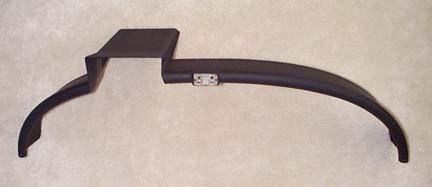
The glareshield with the cover for the GPS 'heads-up display'.
Okay -- part two. As I mentioned in my letter in the June-September FBL, I've also installed a Garmin GPS 400 at the top of my panel, so that it's like a heads-up display. (I would have bought a GPS 430, but Garmin was too slow in coming out with a 14-volt version, and I'll be damned if I'll spend $600 and waste 5 pounds for a 14-28 volt converter which has to be mounted behind frame 6.)
By the way, the display on the GPS 400 is so bright that it's clearly readable even with the sun shining directly on it-this is really necessary in the Falco -- I tried using my laptop in my Falco once and couldn't even see if the damn thing was turned on.
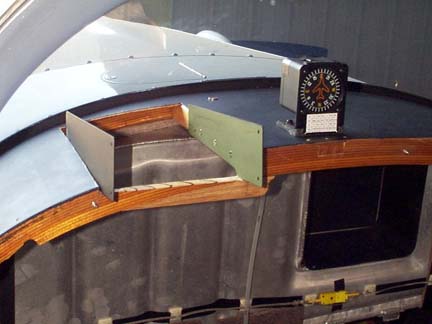
My first chore with the GPS installation was to draft up the arrangement I wanted and see if it would fit -- it did, clearing the windshield by a scant 1/2". I also determined by testing that the GPS 400 in this location wouldn't seriously affect the magnetic compass (it induced a max 3° error, power on or off). With the engineering out of the way, I proceeded to reinforce frame 3, cut out the opening in the plywood between it and the windshield/fuel tank diagonal frame, reinforce the sides of the cutout, and fabricate and install brackets for the GPS rack. I cut the notch in the top of the instrument panel, then took the GPS 400 and the panel to a local avionics shop for wiring. The shop had to replace my Narco CDI with a Garmin model because the Narco one won't work with a GPS in the OBS mode.
While the shop was doing their thing, I modified the glareshield by cutting out a section and splicing in a fiberglass cover for the GPS. For the cover, I first made a plywood model, then a mold and pulled the fiberglass part from the mold. The finished glareshield looks quite good.
(As an aside, the only really good flat black paint I've found for the glareshield is Coast-to-Coast's Black Non-Sandable Primer. It's tough and doesn't gloss-up with rubbing and wear. Unfortunately, since Ace Hardware absorbed Coast-to-Coast I haven't been able to find a good substitute anywhere. Anybody have any suggestions?)
Everything went back together without any problems and systems checkouts were good.
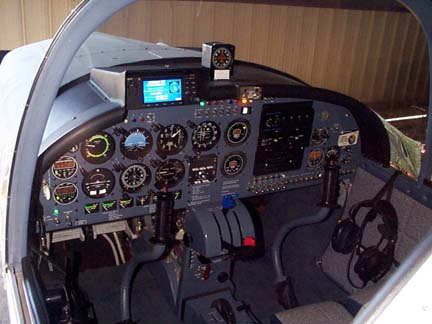
The last thing I did was to install an Electrosystems Magnaflite lightweight starter. If you don't mind the fact that it has a bendix, this is the one to use. The only mod required to the Falco is to put a 90° bend in the positive starter cable mounting lug. It only took about a hour to pull the Prestolite and install the Magnaflite -- easy, and you save 12 pounds.
After putting everything back together and checking out the starter (works very well), I filled the fuel tanks, changed the oil, and did a new weight and balance (it's easier to calculate out the fuel weight and moment than to drain the tanks). The end result of all this stuff is that my bird lost 5 pounds and the c.g. moved a few tenths of an inch aft.
Flying with all this new stuff is a dream -- really a lazy man's way to fly. I second Cecil's assessment: In flight, the S-TEC works beautifully. It holds altitude to within about 20' and tracks the CDI to within about 1/10 mile. I really like having the GPS at the top of the panel -- all the nav info is right there in front of me, so I don't have to look across the cockpit to find it. The GPS 400 has so many bells and whistles that I'm still learning how to use all its features. My only problem now is that one of my lady friends is worried that I'll fall asleep and wake up a hundred miles out to sea.
Oh, yes, a final note for the cost-conscious reader -- the total cost of all this was $16,000, more or less.
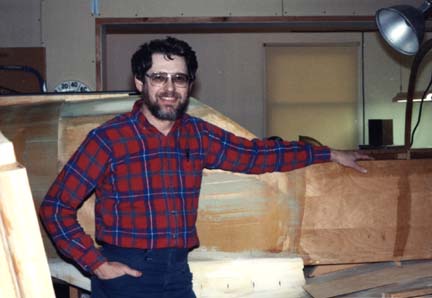
Jim Petty visiting Al Dubiak several years ago.
|
|